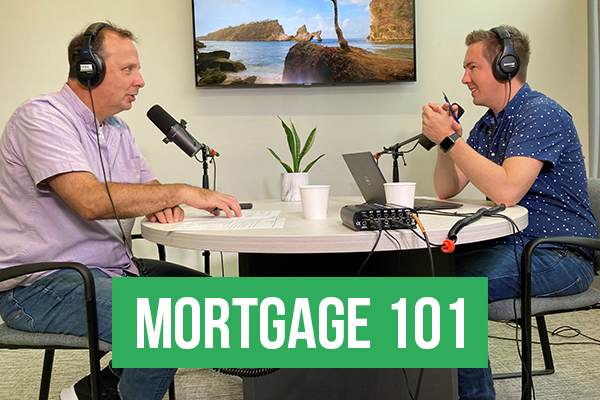Todd Veinotte and Clinton Wilkins discuss the evolving landscape of mortgage lending, highlighting its complexities and the importance of staying informed.

Mortgage 101 – submitting mortgage applications the best way first | August 2021 Part 2
In this episode of Mortgage 101 with Clinton Wilkins and Todd Veinotte, as heard on News 95.7, the guys talk about how to submit mortgage applications in the best possible light, different legal joint statuses between two borrowers on mortgage applications, and touch on what’s happening with construction materials.
Mortgage 101 with Clinton Wilkins & Todd Veinotte – August 2021 – Part 2
Don’t feel like watching the video? Check out the transcript below.
Transcript:
Clinton Wilkins Mortgage Team one of the top mortgage leaders in Canada
Todd Veinotte: [00:00:00:01] Alright, welcome back to a Mortgage 101: Your Guide to Homeownership with myself, Todd Veinotte and Clinton Wilkins, of course, the mortgage guru. Are you the most well versed mortgage guy in Nova Scotia or the Maritimes?
Clinton Wilkins: [00:00:13:06] Well, I would definitely say the Maritimes, 100 per cent. I would say, likely I would be a leader, at least in the thought leadership piece from across the country, at least in the Canadian mortgage broker, brokerage scene.
I certainly, you know, have provided lots of great insights over the years and been awarded Mortgage Broker of the year on the national level. And, you know, certainly provided lots of good info to, you know, mortgage broker news and some Canadian mortgage publications, as well. And I’ve written a book about mortgage lending. So, you know, I don’t think anyone really has done more maybe information and knowledge to the consumer than we have here.
Just if we’re thinking about even the last three years of our show, Todd, just the hours of content that we’ve done. I don’t know if anyone’s really done this level, at least in, you know, in the broadcasting realm.
Lenders are interested in two borrowers’ relationship
Todd Veinotte: [00:01:12:26] Yeah, exactly. Alright. So in the previous segment, we were talking about pride and homeownership. And I thought it was interesting that the dynamic between the lenders is something that borrowers are so intensely interested in, which kind of surprised me, actually. So I wanted to revisit that. Basically, that’s about, in some way they view that as part of the risk of the file.
Clinton Wilkins: [00:01:40:02] Yeah, I think the relationship with the borrower is just so, so important. And, you know, it could be as simple as, you know, a mother daughter. It can be two friends buying a home together. It can be spouses buying a home together. You know, there’s a couple important things to think about there, and it’s about the risk tolerance of the lenders.
Part of the risk tolerance is what do they think, what will happen if one borrower may be taken out of the situation? Can they still afford to pay the mortgage? Does that put, you know, the lender at a higher risk? And sometimes they view, you know, unmarried people, as, you know, archaic as this may seem, less favorable than they do, you know, the typical hetero normative husband wife combination.
As we all know, that’s just as challenging, if not more than, you know, a same sex couple or a mother daughter or two friends. You know, so much, so many hetero normative relationships end in divorce and breakups. I mean, just like every relationship does. But we certainly still get the questions on what’s the relationship with the borrowers. And then the lender decides, you know, if that’s within their risk tolerance or not.
Do those questions lead to discrimination from lenders?
Todd Veinotte: [00:03:04:16] Is there discrimination involved in some way? Do you ever since that’s happening?
Clinton Wilkins: [00:03:10:00] I don’t. I definitely don’t think that there’s discrimination against the borrowers. But I think if it’s a marginal file to begin with and then there’s two maybe friends buying a home together. That may be perceived as higher risk than maybe someone that’s in a relationship.
Todd Veinotte: [00:03:29:25] What if it’s a business partnership? Obviously, it is a business.
Clinton Wilkins: [00:03:33:29] Yeah. Well, if they’re buying a rental property together, sure. I think if they’re buying an owner-occupied property together. That certainly would raise some red flags.
Todd Veinotte: [00:03:43:19] Well, sure, one of them might meet somebody else and then they’ll want to,
Clinton Wilkins: [00:03:46:16] And then maybe the lender is going to have the mortgage paid out, which they don’t want, or maybe the other borrower may be at a higher risk and they don’t want that.
How do you present files to lenders?
So, you know, I think every file is different. And I think that’s what makes the mortgage lending kind of interesting. You know, every file is like a snowflake. And, you know, we can mitigate some of those challenges, but also present the file in the best possible light when we submit it, you know, to a lender.
Todd Veinotte: [00:04:12:20] How do you do that? How do you submit it in the best possible way?
Clinton Wilkins: [00:04:14:16] Well, we look at their income, their assets and their credit, and it’s also about setting the file up correctly. And, you know, I think it’s about asking the right questions up front. And we just don’t throw things at the wall and see if it’s going to stick.
We really want to ask all the information and provide a really good and complete file when we submit it for approval, because it’s a lot easier to get it submitted right the first time. We always kind of refer to this as first time right, than it is to go back and make multiple changes.
Legal joint status between two borrowers can impact a file
The other important thing to think about, and I think we might have talked about this a little bit before, Todd, but I want to touch on it. Based on people’s marital status, it can impact, you know, some.
There can be some legal implications in Nova Scotia, the Matrimonial Property Act applies. It applies to married people. So if you’re on title or not on title, it’s not the same rights to the matrimonial home. And people that are domestic partners in the province of Nova Scotia get those same rights.
Clinton Wilkins: [00:05:11:23] So a domestic partner, someone who would go down to service Nova Scotia and register as a domestic partner. Some people perceive themselves to be common-law if they file their income tax together.
And federal common law, I’m going to use this very air quotey, you know, quote unquote, is different than being a registered domestic partner in Nova Scotia. So I think you should definitely get some legal advice around that. And there’s a couple of different ways you can take the deed. You can take the deed as joint tenants or tenants in common, and that can definitely have different financial outcomes down the road.
If someone were to pass away and where with their interest, then go in that property. So the lenders ask these questions that I think most lenders, if two borrowers are buying a property together, regardless of their marital status, sexual orientation, any of that stuff, they normally always want the deed to be taken as joint tenants, because then the interest would would then go to the other person if they were to pass away.
Todd Veinotte: [00:06:09:24] Ok. Interesting topic on things that, again,
Clinton Wilkins: [00:06:13:21] You don’t even really think about.
Todd Veinotte: [00:06:14:13] Of mortgage lending, you don’t think of these things. Right? But it’s part of the, it’s a really integral part of the application, the dynamic between who’s borrowing.
Clinton Wilkins: [00:06:24:14] Exactly. So, so, so important for sure.
Material prices go up mid-construction, “Someone has to eat that cost.”
Todd Veinotte: [00:06:26:24] Okay, let’s pivot and start talking a little bit about lumber prices. And again, this may spill over into our next segment, depending on how long this takes. But we know that lumber prices went up exponentially over the last year. And because of, a lot of variety of reasons, COVID certainly is a main reason.
Clinton Wilkins: [00:06:43:17] It has been very, very challenging for builders and for people who are buying new construction homes. We’ve seen some major, major delays, but also price increases, which have been so challenging.
So I think, you know, certainly there’s been some great news about the lumber costs coming down. But I’ve heard even, you know, other construction materials have come maybe slightly more in line over the last couple weeks and months. So, you know, that’s certainly positive.
You know, we’re hearing some reports of buyers who had entered into purchase agreements with builders that have been kind of hit with some major price increases kind of at the end when they’re ready to close on their new home. So that’s not great news for us, especially if we had the borrower, because then we have to go back to the lender and try to, you know, explain a big price increase if they’re willing to kind of eat that.
But, you know, I think it’s also challenging for the builder. And I see both sides of it, because I think some builders are definitely having some hard times financially. Imagine if, you know, the prices do increase, but you don’t increase the cost of your end product. Someone has to eat that cost. It’s either the buyer or it’s the seller. And in this case, it’s the builder, you know, and I think, you know, it’s all about that full disclosure.
And I understand it’s a contract, but I’m definitely seeing some builders not wanting to fulfill their contract with the sheer rationale being that they can resell that home for more than they entered the contract, entered into that contract with the buyer, even like a year ago.
Todd redoes his roof, nail prices still expensive
Todd Veinotte: [00:08:21:14] Well, I mean, anecdotally, I’m doing my roof in my home in Springfield. And I and I’m doing it myself, perhaps foolishly at 52. Maybe it’s time to slow down a little bit.
Clinton Wilkins: [00:08:31:11] I mean, get on that roof. Why not Todd. As long as you can show up and be on the radio.
Todd Veinotte: [00:08:35:16] There you go. But I bought a I bought some one and a half, one in a quarter inch galvanized nails. And it wasn’t a big bag. It was 25 bucks. It was one pouch. And I put on five bundles or something like that. And not all that long ago, you could buy a 50 pound box of nails for not much more than that. So prices are, it is a challenge. It’s still remaining a big challenge, though, right?
Clinton Wilkins: [00:08:57:01] Yeah, it’s certainly still a challenge. And we’re hearing, you know, reports from, you know, both sides of that transaction. And, you know, I think that things are going to renormalize in terms of the, you know, the costs of construction materials. It’s going to take some time.
You know, it’s not just that there was supply chain issues. I think there was increased demand, Todd. Increased demand from builders and increased demand for people that were renovating their existing homes.
Todd Veinotte: [00:09:26:04] Alright, we got lots to talk about. Refinance renovations, that’s one of your favorite topics, right? Obviously, so we’ll get to that on News 95.7 when we come back.
If you have any questions, get in touch with us at Clinton Wilkins Mortgage Team! You can call us at (902) 482-2770 or contact us here.


